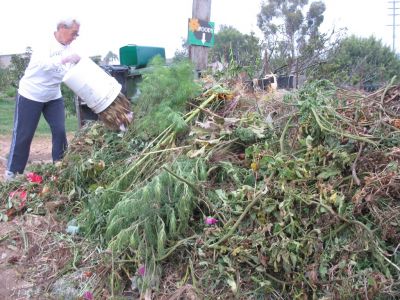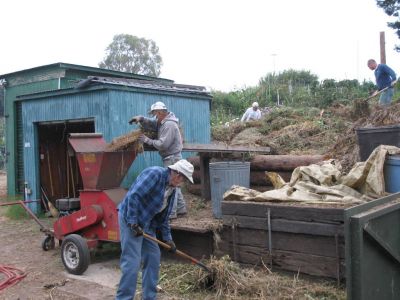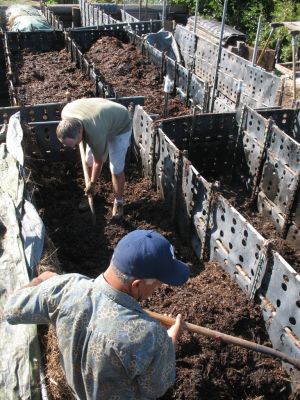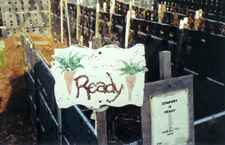




History of Composting at Ocean View Farms
by Karl Lisovsky Phase II; F32 - 34
In the early days of OVF (1977-1988), what is now the Orchard was, in fact, nothing but fruit trees. No sheds, no shredding operation, no composting. At the same time, OVF also had astronomical monthly sanitation bills, because our many dumpsters filled quickly and repeatedly with green waste. We realized early on that we could save money on waste disposal and be a more ecological gardening community if we composted our garden waste. Warren Miyashiro, who has always been at the spiritual center of composting at OVF, was its prime mover early on.
Humble Beginnings
When the garden first started composting in the late 1980's OVF members simply dumped their garden waste somewhere at the side of the orchard, and the compost crew, under the leadership of Randy Zigler, hauled it over to the spot where we'd decided to build a pile that Saturday (long discussions usually preceded this decision). At the time, the orchard had many more fruit trees than it does now, and we located the piles in among them wherever we could. This practice created some controversy, but with time, Composting took over a significant portion of the orchard. We chopped the waste minimally with machetes and shovels. Sometimes we got food waste (from a restaurant or the food co-op), but this proved smelly and unwieldy and the practice was eventually dropped. Horse manure came on soon and for a spell we even used elephant manure, delivered to us from the owner of two elephants who were used in films. It was hard, dirty work in those days. Not having much of a plan, we invested a lot of time and energy for what now seems like little return. Only rarely did we turn a pile, and, believe it or not, we named the piles (something silly like "Nancy's Cat" or "Rick's New Job").
The Early Years
By the early 1990s under the direction of Karl Lisovsky and Don Anderle, we tried to systematize the operation a bit, organizing the piles in color-coded rows and then turning them at somewhat regular intervals. By this time we had our first shredder, so the material was much easier to handle. But without Randy's leadership, crews dwindled. Composting ceased being fun; we even quit naming the piles and struggled hard just to keep the program going. Manure, still stored at the top of the hill, had to be hauled down as we built the piles. Piles were small, only one week's worth of material per pile, which compromised their ability to generate heat and rot well. Until this point, finished compost was scarce, so members were allowed only one wheelbarrow of compost per day.
The Middle Years
In the mid-nineties, several crucial changes happened as Juan González single-handedly industrialized our composting effort. He achieved tremendous space economy by (a) turning piles frequently (encouraging faster rotting and thus volume reduction) and (b) combining piles as he turned them, making the piles larger and higher (promoting heat retention and thus also better rotting). All along, the shredding kept improving, so our product did too. This was OVF Composting's coming of age! I marveled at this solitary man's capacity for work, as he built elegant conical piles and covered them with straw. They reminded me of Monet’s Haystack paintings. Juan worked tirelessly for two years, then quietly disappeared to retire in Mexico. Somehow his enormous contribution was never fully acknowledged.
The Later Years
By the late nineties, what started as a "shred-if-we-can" effort added on to the existing composting program had developed into a Tuesday shredding crew with a mission — and good equipment! The shredding crew was now giving us a beautiful, moist pile of shredded/chipped material to combine with manure and eventually turn into compost at regular weekly intervals. Under the direction of Dean Cleverton and Richard Nortman, long bays (built with fence posts and panels made with electrical conduit and plastic Presto bins) replaced the round haystack-like piles of yesteryear in an effectively organized and highly planned routine, affording the best utilization of space yet. We put a manure pit in the orchard so we didn’t have to haul manure as we built compost piles. A crucial change around this time was maximizing our use of workday crews. Believe it or not, up until this point, composting had all been done by just a handful of people. By this time, we had more material than ever, bigger and more powerful shredders, and best of all, many gardeners have a hand in making the compost. We were finally able to let gardeners take all the compost they wanted.
The Present
The long bays designed and built by Dean and Richard that define the current system with their space/time efficiency were re-oriented around 2004 into their current optimal location and look under the direction of Karl Lisovsky and Richard Nortman. The longer we do this, the more meticulously we control the size of the pieces of debris and the mixture of ingredients. Our reliable shredder and Tuesday morning shredding crew (thanks, guys and gals!) has been providing us with material for many years now, and with the new electric-start engine installed in 2017, we expect years to come. Here's a detailed photo-essay of our current composting operation from start to finsih.
"As I look around today and think back almost thirty years to when we first started hacking away at broccoli stalks with machetes, I wonder why we couldn't have seen into the future then, why we couldn't have made all these improvements more swiftly. I guess that's just the rate of change: slow, steady but in our case, right on target. We were wonderfully naïve back then, eager, and full of energy (good thing, too, what with how much more work it was). Those early days with Randy were our defining years, when we established our commitment to making composting a part of OVF. I wouldn't want to go back to those times now, but I'm sure glad I was there when they happened." — Karl Lisovsky

